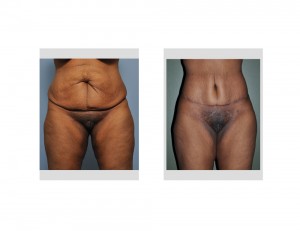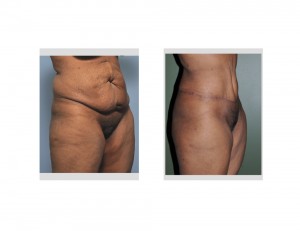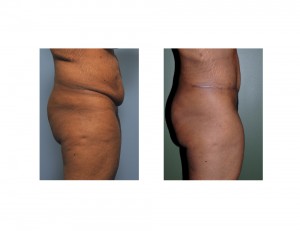Background: Tummy tucks are one of the most common and successful body contouring procedures for women. For those women that are willing to make the commitment to a major surgery, scar and recovery, it can be a near life transforming experience that takes what diet and exercise can do to a whole new level.
Because pregnancy and weight loss affect all women, tummy tuck surgery is done on a very diverse population across all ages and races. But because of varying degrees of skin pigment and the need for a long incision, concerns abound about the potential scar in certain ethnicities. This raises the question of whether, for example, a tummy tuck for African-American women is done differently?
African-American skin, in general, does not heal that differently from skin with less pigment. However it is prone to a higher risk of hypertrophic or keloid scarring and hyperpigmentation, what one may perceive as a too enthusiastic response to scar formation and healing due to the thicker dermis and increased number of pigment cells. Thus one has to check how healing has occurred elsewhere. The simplest test for women is to see their c-section scar, which if it has healed uneventfully, indicates that a tummy tuck scar may do as well.
Case Study: This 35 year-old African-American female wanted to get rid of her loose abdominal skin and improve her waistline. She had two pregnancies and the second one caused a lot of stretch marks, loose skin and weight gain. Through aggressive dieting and exercise, she lost 60 lbs and was finally back to her pre-pregnancy weight but there remained considerable loose skin around her waistline and a lot of stretch marks. She felt she had reached the limit of what her own efforts could improve and she now sought tummy tuck surgery.



However, if one has developed abnormal scarring on their breasts or abdomen from previous surgery, a shorter scar tummy tuck should be planned. Such history is extremely important if the patient has skin excess on their flank areas which is going to require a longer tummy tuck scar to work out the excess skin (dog ears) which will inevitably occur from the elliptical horizontal tissue excisions.
Case Highlights:
1) Abdominal reshaping with a tummy tuck in African-American females is not associated with an increased incidence of abnormal scarring.
2) The African-American tummy tuck has no other ethnic considerations other than wound closure and incisional management.
3) Tummy tuck surgery can cause an abdominal reshaping effect that goes far beyond what diet and exercise can do after one has reached a good weight.
Dr. Barry Eppley
Indianapolis, Indiana


